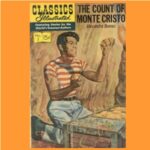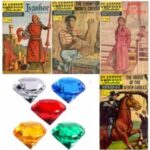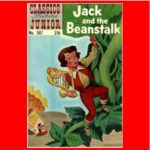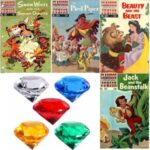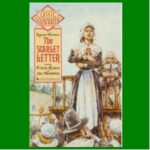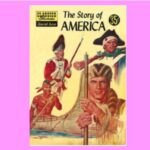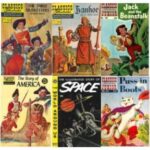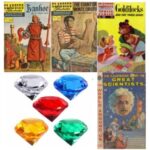Clicking on the following links or images will take you to the various Classics Illustrated comic collections covered in this section:
Reading Classics Illustrated comics (including the Junior versions) was one of the joys of my childhood. The pioneering vision of Albert Kanter in the early 1940s led to the creation of this incredibly rich fount of literary classics presented in an eye-catching and easily digestible format for young readers. It was Classics Illustrated which inculcated in me the joy of reading classic fiction, and for that I will be forever grateful to Mr. Kanter.
The series started publication in 1941 as Classic Comics and became Classics Illustrated in 1947. The latter was formally announced as a ‘newer, truer name’, since the publication was much more than a comic. It was a unique and groundbreaking concept, adapting classic literature into comic-book form with the aim of making the classics more accessible to younger readers as well as a wider audience. The publication was a hit and eventually became one of the most successful comic-book series in history.
During the 1950s and 60s, Classics Illustrated produced an upgraded set of adaptations of classic literature featuring painted covers and redrawn interior art. The revamping was supervised by Roberta Strauss Feuerlicht, who oversaw a team of talented artists and worked closely with the writers to ensure that the adaptations were faithful to the original texts. The painted covers were especially striking, featuring vibrant colors and dynamic compositions that helped to bring the stories to life. While some critics dismissed the comics as simplistic and formulaic, they were widely popular and helped to introduce a generation of readers to the works of authors like Shakespeare, Dickens and Dostoevsky. Today, the comics remain a beloved part of many readers’ childhoods and a testament to the enduring power of classic literature.
The Classics Illustrated series featured the work of many talented artists and writers. Alex A. Blum, one of the series’ most prolific artists, illustrated dozens of issues, and each issue can be considered a classic in every sense of the word. Henry C. Kiefer was another prominent artist whose work came to define the ‘house style’ of the series. Other notable artists who contributed beautiful story art and painted covers included Norman Nodel, George Evans, Lou Cameron, Gerald McCann and Gray Morrow. There were also many skilled writers who adapted the classics into an easy-to-understand narrative while staying faithful to the originals. Alfred Sundel and Ken W. Fitch were the two most notable writers who worked on Classics Illustrated. Together, the artists and writers of Classics Illustrated brought classic literature to a new generation of readers in an accessible and entertaining format.
Although there are multiple versions of nearly every Classics Illustrated issue for the reasons mentioned above, I have selected just a single version for my complete list of issues #1 through #169 based on my personal preferences. In most cases, I have selected the modern version of the story art (unless none exists) as well as the more modern painted covers. Sometimes there are multiple painted covers that were published, and in such cases I have listed both cover artists along with the publication year in parentheses. As an aside, there exists a more formal way of tracking the various versions of Classics Illustrated issues, as explained in the footnote*.
Despite its successes, the Classics Illustrated series faced a number of challenges at various points in its history. In the 1950s, the series faced criticism for its adaptations of horror and crime stories, which were seen as promoting juvenile delinquency. In the 1960s, the series faced competition from other comic book publishers who were producing more contemporary and edgier content. Additionally, the rise of television as a popular form of entertainment contributed to the decline in comic book sales, as fewer children were interested in reading. Because of this, the publication of new Classics Illustrated titles was halted after issue #167 in 1962, though reprints of earlier titles continued to be published throughout the 1960s. Finally, in 1969 the two final titles in the series (#168 and #169) were published. After continuing for a couple more years with some newly repainted covers (and one redrawn story) the company ceased publication in 1971, marking the end of the Classics Illustrated era.
There were several spinoffs of the main Classics Illustrated series, of which the most well-known (and my childhood favorite) was the Junior series, launched in 1953. This series was aimed at children and adapted classic fairy tales and fables for a younger audience. One of the characteristic features of Classics Illustrated Junior was its vibrant and colorful artwork, which made the stories more accessible and engaging for young readers. Some notable artists who worked on the Junior series were William A. Walsh, Dik Browne, Lin Streeter, Pete Costanza and Mike Sekowsky.
Another notable spinoff was the set of sixteen Classics Illustrated Special Issues, which ran from 1955 to 1964. These comics presented non-fiction stories in an expanded format of 96 pages, which nicely complemented the classic fiction presented in the regular Classics Illustrated issues which had 48 pages. The beautifully crafted special editions afforded young readers a wealth of informative material that exceeded in scope anything attempted previously in the comics medium and they have endured as an unforgettable addition to the world of comic books..
Yet another spinoff, The World Around Us, was a series of non-fiction educational comics which was launched in 1958. These comics covered a diverse array of subjects, including history, science, nature and exploration, allowing readers to delve into various aspects of the world’s wonders. (Slightly different versions of the same books were published in the UK as the World Illustrated series, starting in 1960.) The World Around Us, with its educational focus and talented contributors, left a lasting impact by making learning an enjoyable and immersive experience for readers of all ages.
In 1991, a second series of Classics Illustrated was launched by Berkley Publishing Group. The issues had a much more modern sensibility and featured contributions by well-known contemporary artists. Unlike the original Classics series, the second series featured more detailed and accurate adaptations of the source material. Despite being critically lauded, the series was not successful commercially and lasted for only two years. Nevertheless, it is still regarded a valuable addition to the Classics Illustrated family of comics.
Throughout its publication history, Classics Illustrated and its various spinoff series have had a significant impact on the comic book industry and on the wider culture. The series has been credited with introducing many readers to classic literature and inspiring them to read the original works. While the publication faced many challenges during its history, its impact on the comic book industry was indisputable and it continues to be fondly remembered and appreciated by readers today.

